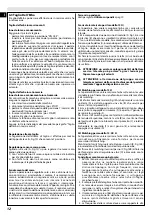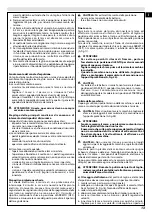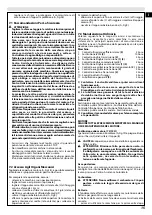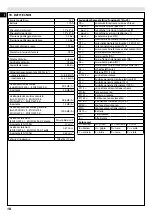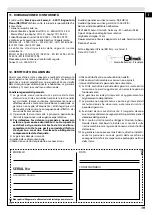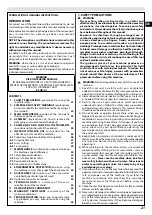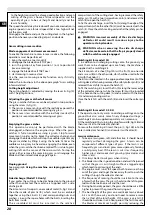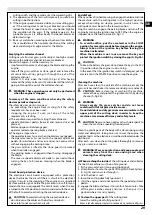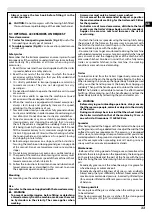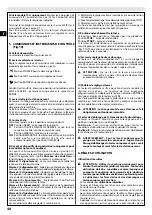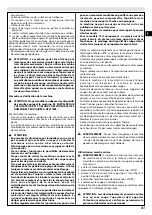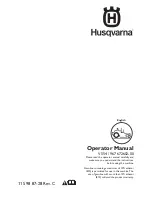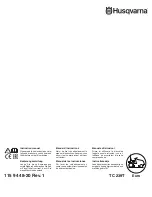
GB
26
WARNING: Drive down slopes with the cutting unit in
the lowest position possible in order to lower the
machine’s centre of gravity and increase its stability.
Control your downhill speed by releasing the speed adjustment
pedal (to take advantage of the hydrostatic drive’s braking
effect) and the accelerator lever.
To work on sloping ground proceed as follows:
- Mow upwards and downwards (the slope), not sideways.
- Never drive the machine on terrain that slopes more than 10°
(17%).
- Avoid starting or stopping on a slope. If the tyres begin to
slip, stop the blade and drive slowly down the slope.
- Always drive evenly and slowly.
- Make no sudden changes in speed or direction.
- Avoid unnecessary turns, and if it proves necessary, turn
slowly and gradually downward. Drive slowly. Make small
movements with the steering wheel.
- Watch out for and avoid driving over furrows, holes and
bumps. On uneven terrain, the machine can tip more easily.
Long grass can hide obstacles.
- Do not mow or stop near verges, ditches or banks. The
machine could overturn suddenly if a wheel goes over the
edge of a drop or ditch, or if an edge gives way.
- Do not mow wet grass. It is slippery and the tyres can lose
their grip, causing the machine to slide.
- Do not try to stabilise the machine by putting a foot on the
ground.
- Be particularly cautious near corners, bushes, trees or other
objects that block your view.
Children
- Failure to be on guard for children in the vicinity of the
machine may result in serious accidents. Children are often
attracted to the machine and mowing work.
- Keep children away from the mowing area and under close
supervision by another adult.
- Be alert and switch off the machine if children enter the work
area.
- Before and during a reversing manoeuvre, look backward
and downward to make sure there are no small children.
- Never allow children to ride with you. They can fall off and
injure themselves seriously or prevent safe manoeuvring of
the machine.
- Never allow children to use the machine.
6.1 Preliminary Operations Before Starting Work
Before starting work, it is necessary to carry out a series of
checks and operations on the machine to ensure maximum
safety and productivity.
Seat adjustment
The seat is secured by means of four screws (C, Fig.6) which
must be loosened to change the position of the seat, which is
done by sliding it along the slots in the base. Once you have
found a comfortable position, fully tighten the four screws.
Filling with oil and fuel
CAUTION: The engine manual indicates what type of oil
and fuel to use.
Oil
CAUTION
- THE MACHINE IS SUPPLIED WITHOUT OIL. Add engine oil
before starting the machine. The tank’s capacity is about 1.4 litres.
- Running the engine with insufficient oil can cause serious
engine damage. Be sure to check the engine on a level
surface with the engine stopped.
- Using non-detergent oil or 2-stroke engine oil could shorten
the engine’s service life.
To reach the oil level dipstick, lift up the seat and remove the
cover (A, Fig.8). Then unscrew the cap (B). With the engine
stopped, check its oil level which must be between the MIN
and MAX marks on the dipstick.
Fuel
WARNING
- Petrol is a highly flammable fuel; observe extreme
caution during use. Do not smoke or bring any fire or
flame near the fuel or the machine.
- Petrol and petrol fumes can cause serious injury when
inhaled or allowed to come in contact with the skin. For
this reason observe caution when handling fuel and
make sure there is adequate ventilation.
- Pay attention to the risk of poisoning from carbon
monoxide, an odourless, toxic and lethal gas.
- Handle fuel outdoors where there are no sparks or flames.
- Select bare ground, stop the engine, and allow to cool before
refuelling.
- Never use stale or contaminated petrol or an oil/petrol
mixture. Avoid getting dirt or water in the fuel tank.
- Avoid dripping petrol onto plastic parts to prevent them
being damaged. In the event of accidental spillages, rinse
immediately with water. The warranty does not cover for
damage to plastic parts of the bodywork or the engine
caused by petrol.
- Loosen fuel cap slowly to release pressure and to keep fuel
from escaping around the cap.
- Clean surface around fuel cap to prevent contamination.
- Prior to replacing the fuel cap, clean and inspect the gasket.
- Tighten fuel cap securely after refuelling. Unit vibration can
cause an improperly tightened fuel cap to loosen or come off
and spill quantities of fuel.
- Wipe spilled fuel from the unit and allow remaining fuel to
evaporate. Move 3 m away from refuelling site before starting
engine.
- Never attempt to burn off spilled fuel under any
circumstances.
- Never place the machine in an area with combustible
materials such as dry leaves, straw, paper, etc.
- Never take the cap off the tank when the engine is running.
- Take care not to get fuel on your clothing. If you have spilled
fuel on yourself or your clothes, change your clothes. Wash
any part of your body that has come in contact with fuel. Use
soap and water.
- Do not expose the fuel tank to direct sunlight.
- Store and transport fuel in a clean container approved for
petrol.
- Store fuel in a cool, dry, well-ventilated place.
- Store the unit and fuel in an area where fuel vapours cannot
reach sparks or open flames from water heaters, electric
motors or switches, furnaces, etc.
- Keep fuel out of reach of children.
- Never use fuel for cleaning operations.
WARNING
- Refuelling should be carried out in an open and well-
ventilated area with the engine off. Always remember
that petrol fumes are inflammable. DO NOT USE A NAKED
FLAME TO LOOK INSIDE THE TANK AND DO NOT SMOKE
WHEN REFUELLING.
Summary of Contents for Rider 72
Page 5: ...S1 S3 Q1 H1 Q0 B Q0 3 S6 X115 2 S2 S4 Q0 Q1 Q1 1 S3 S7 S1 S4 S2 S6 25 ...
Page 6: ......
Page 8: ......
Page 201: ......

